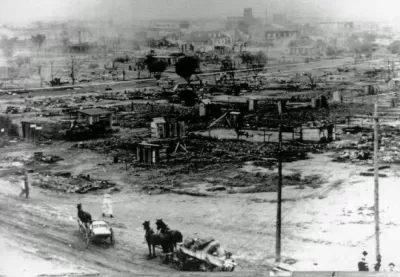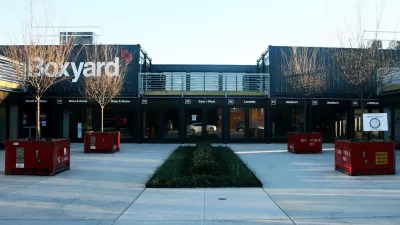On the hundred-year anniversary of the violence that destroyed Tulsa's "Black Wall Street," the country is finally reckoning with the legacy of one of the most destructive racially motivated riots in U.S. history.

What The Tulsa Race Massacre Destroyed
"Places to work. Places to live. Places to learn and shop and play. Places to worship." This piece from the New York Times describes the thriving neighborhood of Greenwood, its promising future, and the generational wealth that was destroyed during the 1921 massacre. "Piecing together archival maps and photographs, with guidance from historians, The New York Times constructed a 3-D model of the Greenwood neighborhood as it was before the destruction."
The true costs of the Tulsa race massacre, 100 years later
In this history of Tulsa's lost wealth, survivors of the massacre and their descendants recount the double history of Greenwood's destruction—once at the hands of the racist mob in 1921, and again as redevelopment and freeway construction swept the city during the "urban renewal" period of the 1960s and 1970s. A Brookings Institution analysis assesses "the estimated dollar amounts of lost wealth from the 1921 massacre, and consider[s] what that collective wealth might be able to accomplish in contemporary Tulsa were that money still in circulation." According to the American Journal of Economics and Sociology, the property destroyed in the massacre would be valued at $200 million today. "If restored to the community in the form of reparations, what could that lost wealth pay for today?"
Tulsa Race Massacre Sidelined Legacy of Black Wealth in Greenwood
The Wall Street Journal examines the economic legacy of the destruction of "one of the nation’s most prosperous Black communities" and how "the massacre disrupted the growth of assets that could have been passed to [descendants] or used to start other ventures." The gap in wealth between Black and white Americans continues to grow. "Black people have shown the ability to create wealth, but have never had the opportunity to compound wealth," says Harry Hollines, chief strategy officer for the Latino Leadership Institute.
Tulsa's Greenwood neighborhood found prosperity after the 1921 massacre. Then the highways arrived.
After the massacre, Greenwood experienced a "second renaissance" as Black Tulsans rebuilt "bigger than before," helping Greenwood once again become, as W.E.B. Dubois called it, "a happy city" with "new clothes." However, Carlos Moreno's new book, The Victory of Greenwood, recounts the neighborhood's resurgence and its subsequent destruction by freeways and redevelopment when residents were again robbed of their property through eminent domain. "Greenwood’s current and former residents are still calling for justice, whether through equity in property ownership, or the removal of the highways. Many say they still don’t have a seat at the table when it comes to the fate of what was once the country’s most culturally vibrant and financially successful Black neighborhood."
Black Land Ownership Primed Greenwood’s Rebound After Massacre
To rebuild Greenwood after 1921, local entrepreneurs and landowners received "little or no government assistance," with insurance companies denying claims and business owners facing the loss of their inventory with no safety net. But "[m]any residents instead used their property as collateral to secure short-term mortgages from financial institutions, more affluent individuals and community lending pools," letting the neighborhood recover to the point that, by 1940, the Black homeownership rate outpaced white homeownership in Tulsa. "Greenwood’s second calamity was, in part, a consequence of broader urban renewal efforts in the 1960s. Redevelopment plans and the clearing of blighted properties uprooted local businesses and residents, accelerating the neighborhood’s decline, residents and descendants of former business owners said." Eventually, the construction of a new interstate freeway "upended the local economy, piercing the heart of the business district and forever changing the neighborhood."
"Massacres are the violence inherent to white supremacy unleashed in full force. Taking untold scores of Black lives, these massacres have largely been erased from the public consciousness." These events, "systematic expressions of white supremacy," were "not isolated footnotes of American history." A map from Decolonial Atlas illustrates the long-suppressed history of some of the other race massacres perpetrated around the country.
Chicago had a ‘Black Wall Street’ too
As America reckons with its history of racist violence, it has become apparent that incidents like the massacre on Tulsa's "Black Wall Street" happened all too often. From St. Louis to Chicago to Atlanta, riots and attacks "fueled by racial and economic tensions" led to the deaths of hundreds of Black Americans and the loss of untold Black wealth. Yet in spite of the violence they faced, writes Clarence Page, Black Americans "turned oppression into opportunity, as well as they could within the confines of racial segregation, much like the workers and business owners in Tulsa and other 'Black Wall Streets' under Jim Crow segregation."
Not just Tulsa: Racist mobs were 'widespread and a constant concern' 100 years ago
Far from being "the only tragedy of its kind," the violence in Tulsa exemplified a virulent wave of racist attacks that "peaked over the course of 10 months in 1919 when more than 250 African Americans were killed by white mobs in at least 25 riots across the country." In Elaine, Arkansas, "[m]ore than 200 Black men, women and children were killed" after Black sharecroppers attempted to unionize. Rosewood, Florida's Black population fled the town altogether when a white mob burned Black homes and businesses after an alleged attack on a white woman. Racially motivated violence was, for many people, a terrifying and "constant concern."

Alabama: Trump Terminates Settlements for Black Communities Harmed By Raw Sewage
Trump deemed the landmark civil rights agreement “illegal DEI and environmental justice policy.”

Study: Maui’s Plan to Convert Vacation Rentals to Long-Term Housing Could Cause Nearly $1 Billion Economic Loss
The plan would reduce visitor accommodation by 25% resulting in 1,900 jobs lost.

Why Should We Subsidize Public Transportation?
Many public transit agencies face financial stress due to rising costs, declining fare revenue, and declining subsidies. Transit advocates must provide a strong business case for increasing public transit funding.

Paris Bike Boom Leads to Steep Drop in Air Pollution
The French city’s air quality has improved dramatically in the past 20 years, coinciding with a growth in cycling.

Why Housing Costs More to Build in California Than in Texas
Hard costs like labor and materials combined with ‘soft’ costs such as permitting make building in the San Francisco Bay Area almost three times as costly as in Texas cities.

San Diego County Sees a Rise in Urban Coyotes
San Diego County experiences a rise in urban coyotes, as sightings become prevalent throughout its urban neighbourhoods and surrounding areas.
Urban Design for Planners 1: Software Tools
This six-course series explores essential urban design concepts using open source software and equips planners with the tools they need to participate fully in the urban design process.
Planning for Universal Design
Learn the tools for implementing Universal Design in planning regulations.
Smith Gee Studio
Alamo Area Metropolitan Planning Organization
City of Santa Clarita
Institute for Housing and Urban Development Studies (IHS)
City of Grandview
Harvard GSD Executive Education
Toledo-Lucas County Plan Commissions
Salt Lake City
NYU Wagner Graduate School of Public Service






























